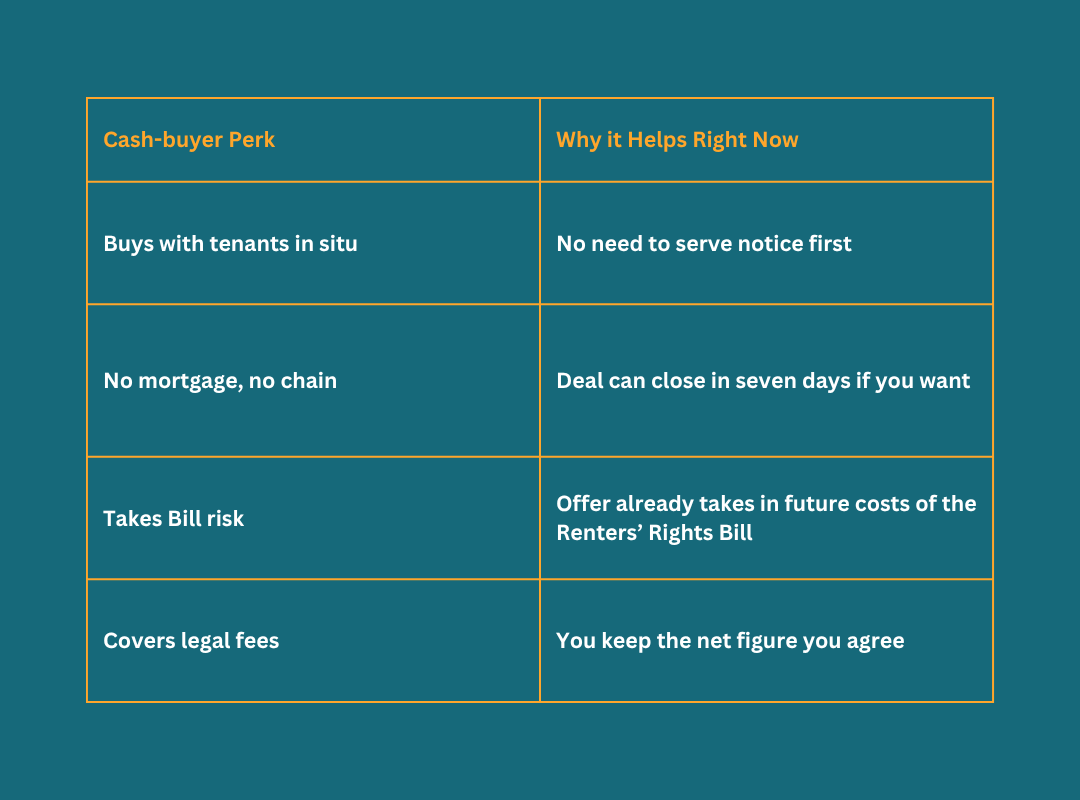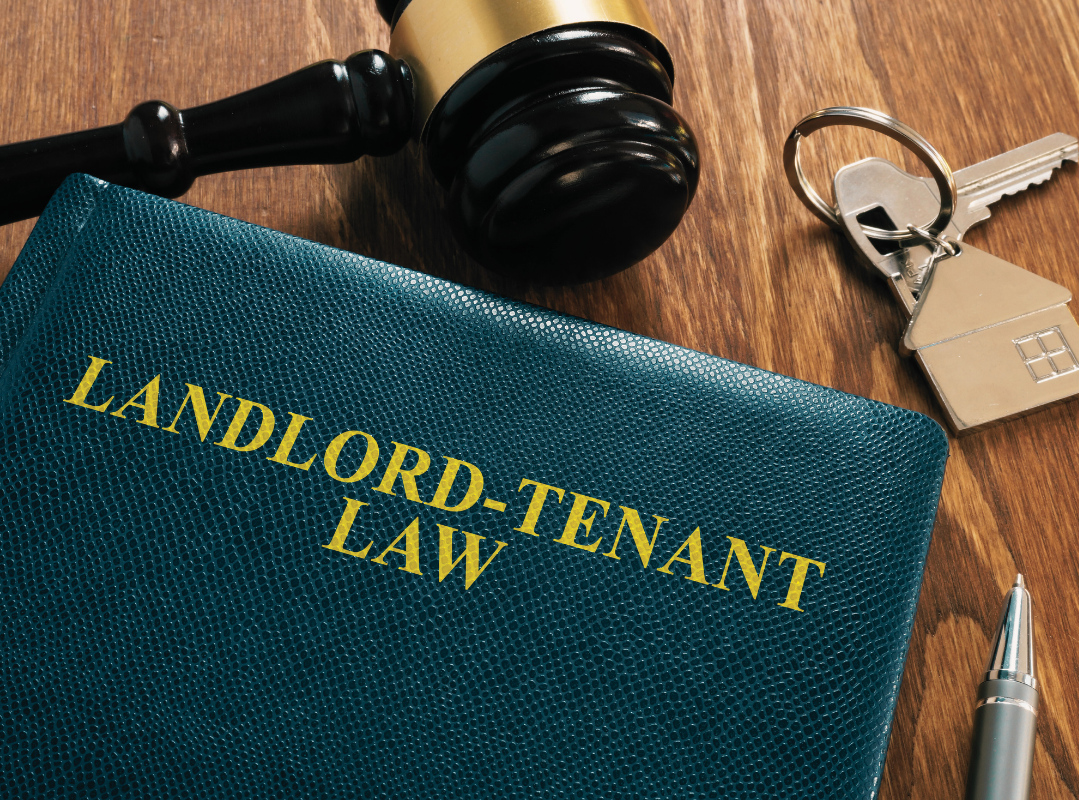The Renters Rights Bill keeps shuffling forward, but the finish line still lies ahead. MPs sent the draft law to the Lords in January, and peers wrapped up their line-by-line review on 15 May 2025. Ministers have not yet given it time for the next Lords report stage, making it clear they are “in no rush” to push it through.
Even so, most analysts agree the Bill – or a very similar set of rules will pass and start to bite late-2025 or early-2026. That delay has not calmed landlord nerves: new NRLA polling shows 38 % plan to sell, while only 7 % want to buy more rental homes. If you own a let and feel boxed in, a cash buyer can still give you a fast, clean exit. Let’s run through the facts.
Contents
What is the Renters Rights Bill?
The Renters Rights Bill is a draft law now in the House of Lords that aims to reset the rules for England’s private rentals. In plain terms, it would:
- Scrap “no-fault” Section 21 evictions, so landlords could only regain a home if they prove a valid ground, such as sale, rent arrears, or serious breach, if they need the tenant to leave.
- Turn every tenancy into a rolling monthly agreement, ending fixed terms and letting tenants leave with two months’ notice, while some possession grounds may need up to four months.
- Create a free, mandatory Ombudsman and a new digital Property Portal, giving renters an easy route to complain and letting regulators track compliance. Landlords must join and pay a small levy.
- Make pets the default “yes,” unless a landlord has a clear refusal reason.
- Raise home-quality rules to align with the Decent Homes Standard, clamping down on damp, mould and other hazards.
The Commons Library confirms the Commons cleared the Bill back in January 2025. A fresh House of Lords report date is still “to be announced”, so Royal Assent can’t arrive before late-2025. Once it does, the government must give at least two months’ notice before the first rules kick in, and most experts expect a phased start running into early 2026.
Why Landlords Feel Jumpy
1. No More Quick Exits
The Bill abolishes Section 21 “no-fault” evictions for all existing and future tenancies at the same time. Landlords will have to rely on Section 8 grounds and prove the case in court.
- Longer timelines: Ministry of Justice figures already put the average journey from notice to possession at 22 weeks.
- Court backlog risk: A third of current possession cases use the accelerated Section 21 route; once that shortcut disappears, the courts must absorb thousands more hearings. Landlord groups warn of a “car-crash” unless extra judges and bailiffs are hired.
- Surge before the ban: Section 21 claims jumped 49 % in 2023 as owners rushed to evict early – evidence of how heavily some portfolios depend on the pressure valve the Bill will remove.
If a tenant stops paying rent, you can no longer regain possession with a two-month Section 21 notice. You must gather evidence, serve a Section 8 notice and queue for a hearing, tying up cashflow for months.
2. Rolling Contracts = Surprise Voids
Every fixed-term assured shorthold tenancy converts to a monthly periodic agreement on the Bill’s start date. Tenants can quit at any point with 2 months’ notice; landlords who need the property back to sell or move in must give 4 months’ notice and wait at least 12 months from move-in before using that ground.
- Flashing vacancy risk: A tenant could sign on Monday and serve notice on Tuesday, leaving after 60 days. Lenders and insurers price that instability into tighter criteria and higher premiums.
- Costs still high: Average buy-to-let fixes sit around 4–5 %, and analysts expect fresh rises if gilt yields keep climbing in 2025. A sudden two-month gap wipes out a year’s net profit on many leveraged properties.
Your scheduling cushion disappears. Unless you hold big cash reserves, a two-month void can push a mortgaged unit into the red.
3. Rule-Stacking: EPC-C and More Bills
The Renters Rights Bill arrives on top of an Energy Performance Certificate deadline that forces every rented home to hit EPC C by 2030.
- Scale of the task: 2.6 million PRS homes still sit below category C; reaching the target could cost landlords £17 billion in total.
- Per-property hit: The average upgrade from E–G to C is £13,500; in the North East or Wales, that equals 80 % of a year’s rent.
- Tipping point: NRLA research shows many landlords will offload units if upgrade costs exceed £10,000, often to fund work on the rest of the portfolio.
Add compulsory membership of the new Ombudsman, a paid-for landlord database and stricter fitness-for-habitation rules, and yearly overheads keep climbing.
Improving one 1930s terrace might be fine; upgrading three or four can swallow your rainy-day fund, and lenders rarely advance cash for retrofit work.
4. The Information Gap
Government polling shows just 7 % of landlords now plan to expand their portfolios, while 31 % aim to shrink or exit within two years.
- The NRLA’s Q1 2025 Confidence Index found 38 % of landlords intend to sell and only 7 % plan to buy, figures that it links directly to the Renters Rights Bill and EPC costs.
- Tenant-side surveys echo the trend: 56 % of renters forced to move in early 2025 said their landlord was “selling up,” up from 37 % a year earlier.
- Many small landlords admit they still do not fully understand the Bill or its timelines, driving decisions based on fear of the unknown rather than firm numbers.
Confusion itself becomes a cost. Owners who lack time to decode 200-plus pages of legislation often decide the safest option is to exit before the rules land.
Why an Open-Market Sale Drags
- Viewings are awkward. Tenants can refuse weekday access, slowing marketing.
- Mortgage buyers baulk. Lender’s dislike of sitting tenants and future possession risk.
- Chains wobble. Survey surprises—damp, knotweed—trigger chips or walk-aways, as countless “problem property” guides warn.
House price data already shows small monthly dips, adding time risk for anyone waiting to find a “perfect” buyer.
Benefits of a Cash Buyer

The price will sit below full retail, but you trade a long wait for money in your account this month.
A Six-Step Exit Plan
- Gather your papers: tenancy, gas cert, EPC, deposit details.
- List your numbers: mortgage balance, repair quotes, energy-upgrade cost.
- Call two or three cash buyers: check proof of funds and Companies House filings.
- Compare net offers: who pays legal fees, and how long is the price valid?
- Pick a date that suits: many sellers align with a mortgage fix ending.
- Let solicitors handle the rest: you sign, funds land, buyer takes on the Renters Rights Bill risk.
Key takeaways
- The Renters Rights Bill is through the Lords committee but still waits for its next stage; Royal Assent will likely arrive late 2025.
- It ends Section 21, forces rolling contracts and adds extra duties.
- Up to 38 % of landlords now plan to sell, fearing new rules.
- Selling through an agent with tenants can drag and invite price cuts.
- A direct cash buyer offers speed, certainty and freedom from the coming law.
FAQs
Q1. Will the Renters Rights Bill pass? The Bill has cleared all Commons stages and Lords committee; few expect it to be dropped.
Q2. Do I need to evict first? No. Many cash buyers take the property with tenants and handle notice under the new law.
Q3. What price can I expect? Most cash buyers pay around 80–85 % of open-market value, reflecting speed and risk transfer.
Q4. What if my tenant stops paying rent during the sale? Because the buyer uses cash and knows the situation, deals rarely stall; any arrears are priced in.
Q5. Is waiting for higher prices smarter? Maybe, but rising supply from other exiting landlords could cap gains, while the Bill’s rollout could make sales slower.
Related articles


